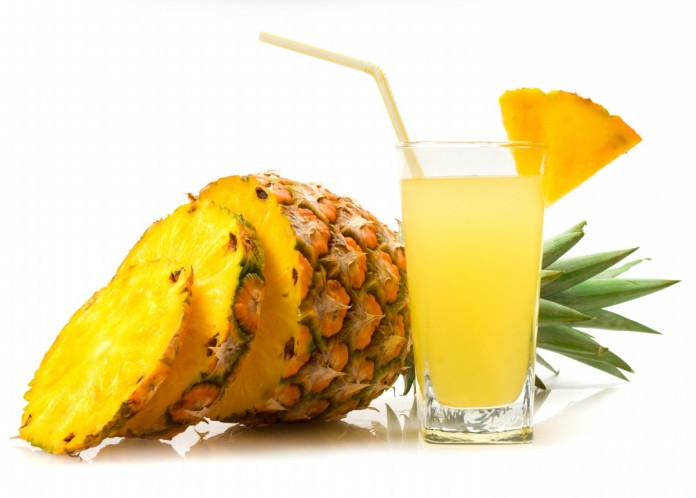
By Rabbi Yair Hoffman for the Five Towns Jewish Times
PROBLEMS WITH INSECTS
Believe it or not, there are three different areas in which Halacha and pineapples intersect. These areas have to do with insects, the laws of Orlah, and the bracha that is recited on them.
The first issue is one that, perhaps unbeknown to the average consumer – is a huge halachic problem.
INSECTS
We will begin with insects.
Mites or other insects can be found in three different areas of the pineapple. They can be found on the crown and on the leaves of the crown. These leaves are often infested with curly white worms. Mites can also be found on the outside of the pineapple. Originally, party planners at various Jewish simchas would often use the pineapple skins to garnish fruit platters. However, it was soon discovered that mites which had originated from the outside of the pineapple skin actually got into the cut up fruit. Upon discovery of this problem, most of the party planners agreed to refrain from decorating fruit platters with pineapple skins.
The mites enter the pineapple from the outside and often worm their way into the blossom cups of the pineapple. Indeed, since the blossom cups extend into the flesh of the pineapple, they are technically within the pineapple itself. The brown spots on the outside of a cut-up pineapple may often have mites. This can present a problem if careful attention is not paid as to how the pineapple is cut up. Dole pineapple juice, for instance, when checked with a mesh cloth will more often than not will reveal mites. Individuals who cut up pineapples should make sure that no part of the blossom cup remains on any pineapple slice and that they rinse off the cutting board after the blossom cups have been cut off.
This author was told that when many of the kosher agencies became aware of this, they made changes to how the pineapple was processed in the companies in which they supervise.
PACKING IN PINEAPPLE JUICE
Dole and Del Monte brands pack their slices in 100 percent pineapple juice. Many of the Jewish companies instead packed their canned pineapple in sugar water. The reason for this, it seems, was because the juice would often have mites.
There are two ways that companies produce juice from pineapples. They will either take the entire pineapple, peel and all, and use enzymes to remove even more juice from the fruit. A second method is that they take out the center core and get juice out of it.
Unger’s, under the New Square Kashrus Council, only made production where the second process was used. However, this too proved to have mite infestations. To address this issue, the New Square Kashrus Council decided to substitute the pineapple juice with a syrup made of sugar, water and citric acid. That was done in January of 2015. They were the first Kashrus agency to require this.
MITE PROBLEM NOT ELIMINATED WITH SYRUP
According to Rabbi Wagshal, administrator of New Square Kashrus Council, although substituting syrup for pineapple juice did address much of the problem, the problem was not entirely eliminated. New Square checked one hundred cans of the pineapple cans produced under their supervision. They found three mites in the hundred cans. Although technically there is a rationale that this is not considered miyut hamatzui, New Square felt that it was not ideal. Their first and last product was in January of 2015.
New Square Kashrus Council now does have a system as to how to produce mite-free pineapples, but the company is getting back to them as to how much the requested additional machinery to rinse the cut up pineapples will cost, and whether it would justify the outlay.
It should be noted that if one does wish to avoid mites, pineapple juice should be avoided and the slices and or chunks should be washed from any pineapple juice. For those canned pineapples in syrup, there still may be mites in 3% or so of them. Each person should consult his own Posaik as to what to do.
IS THERE A PROBLEM OF ORLAH?
The second halachic issue has to do with Orlah. The first three years of a tree’s fruits are called Orlah and are forbidden to be eaten. We may also not derive benefit from them. The laws of Orlah apply in Chutz La’aretz, and we rule that it they even apply to the fruit trees of a gentile. There is a concept that when we have a doubt in Chutz La’Aretz in regard to Orlah we are lenient. However, regarding pineapples, it is well near impossible for the fruits not to come from the first three years.
But let’s go back for a little history. The pineapple is originally a product of South America, and did not exist in Jewish communities in the times of the Rishonim. In 1493, Columbus found it on the island of Guadalope and brought it back to Europe. One of its properties was that it protected sailors against scurvy. The Jewish sailors on Columbus’ ships were probably the first Jews to encounter it. They were probably the first to decide whether it was a tree or a bush. The pineapple plant is a herbaceous perennial. That means that it is not woody, and the plant dies down to the ground every year, but has roots in the bottom that make the plant rise again.
That issue is not a moot point, however, as this halachic issue is being presented to Poskim by a Lakewood based Talmid Chochom.
There are essentially two sources in the Talmud that deal with the issue of how we define a tree. In Brachos 40a, the Gemorah deals with one issue. The Tosefta in Klayim (3:13) states that when its leaves stem from its trunk, it is a vegetable and when its leaves do not – it is considered a tree.
The Rosh (as explained by the Bach) is of the opinion that if its trunk exists in the ground from year to year and its leaves do not come from the trunk it is halachically considered a tree.
The Ramah (Siman 303) is of the opinion that a plant is only considered a tree when its trunk is above the ground from year to year, but if it is below the ground it would be considered a vegetable. This is based upon the opinions of the Gaonim.
The opinion of Rav Hai Gaon is that if its branches last from year to year, it is considered a tree, and if not, it is considered a bush or vegetable.
The Chayei Odom (51:7 – see Nishmas Adam as well) writes that anything that remains from the trunk from year to year is considered a tree.
The Rambam’s view as ell seems to have pineapples as emanating from a tree
There are a few factors, however, that can make the case that it is a vegetable – one cited in the Birchei Yoseph (YD 294 quoting the Maharam Alshich) that if the quality of the fruit reduces significantly as the tree continues to grow – then it is considered a vegetable. Rav Shlomo Zalman Revach from Eretz Yisroel concludes that it is a vegetable for this reason (See Chelkas HaSadeh Vol. I Orlah #15).
When the issue was presented before Rav Hershel Schachter of the OU, he responded that the Chazon Ish (Orlah 12:3) held that if the tree does not live beyond the fourth year in Chutz LaAretz, and that if it produces fruits in the first year, and that if the quality of the fruit reduces significantly as the tree continues to grow – in Chutz La’Aretz we are lenient.
It is this author’s understanding that the issue is still before other Gedolei HaPoskim. Hopefully, we will have their opinions shortly.
BRACHOS
The issue of whether to recite a HaAdama or a HaEitz would be dependant upon the conclusion to the previous section, but we know that if one recites a HaAdama on a fruit of a tree one has fulfilled the blessing as well (see SA 206). The question is, however, is it preferable to have a different vegetable in which one would recite a HaAdama instead of doing so on the pineapple? The Birchei Yoseph and the Shaages Aryeh both indicate that if there is another HaAdama present – than that is preferable.
The author can be reached at [email protected].
{Matzav.com}












A pineapple is like a word of humor. If you smile, it will make the silly safer to think.
Great way to enjoy a good tropical day.
why cant they filter the bugs out the juice?